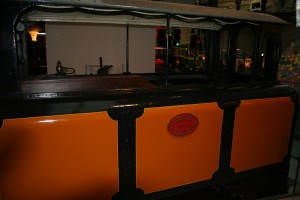A brief history of the London Underground
To understand why in 1863 the Victorians thought that it would be a good idea to have trains running in tunnels under a city you first have to understand the background of the United Kingdom’s railway system.
The 19th century saw rapid development in railway services to London, but the many mainline terminals were situated some distance from the City of London (Waterloo, Euston, King’s Cross, Paddington etc.)

Entrance to original tube carriage – in the London Transport Museum
It was this time of the Victorian Railway Mania that many schemes for underground railways were suggested, to help ease the ever-increasing traffic congestion in London, many ideas were put forward from 1844 onwards: few were successful.
For some years the building of the railway was hampered by the inability to raise the capital required. However, when in 1858 they advocated the provision of “cheap railway accommodation to enable working classes to reside in their adjacent country districts” the funds at last became available. Work first began between Paddington and King’s Cross the form of construction was cut-and-cover.
In 1863 the world’s first underground railway system began in London, United Kingdom (by Metropolitan Railway), by 1880 it was carrying 40 million passengers a year. It is now known as “The Tube” or “London Underground”. The London Underground as the name suggests serves Greater London and some of the surrounding areas. It is not, however completely underground; in fact over 50% of the system is above the surface.
Steam locomotives were used on the world’s first underground railway – ‘the Metropolitan’ – between Paddington and Farringdon.
The engines were adapted to reduce the amount of smoke and steam. The Cut and Cover technique used to create the Underground railway was used to provide ventilation, by not covering parts of the line to allow for the excess steam and smoke. Pollution however, remained a problem for steam operation underground.

Tube engine – in the London Transport Museum
Electric trains were successfully introduced in 1890 on what is now part of the Northern Line. All the deep level lines were electric and the cut and cover lines (Circle, District and Metropolitan) followed. The system was completely electric by 1925, but steam engines were used for engineering trains until 1971.
In the many years of the Underground running there have been numerous additions to the system, so that it now includes 275 stations and over 250 miles of track.